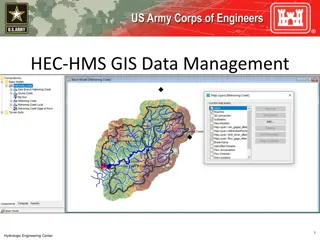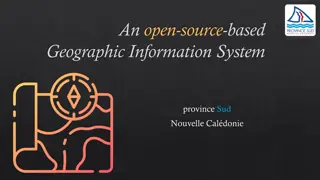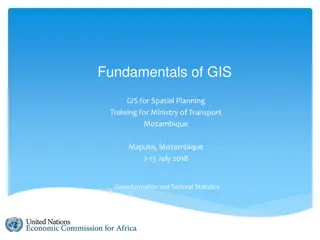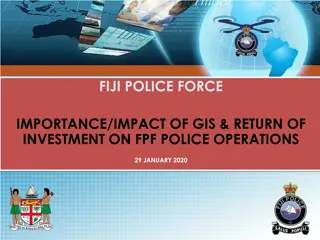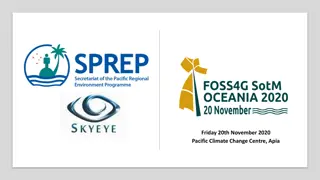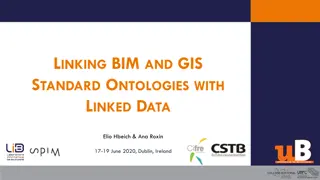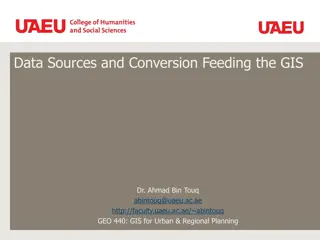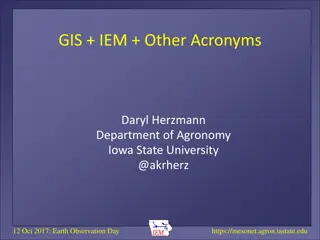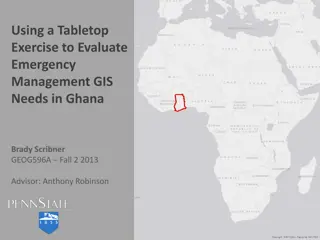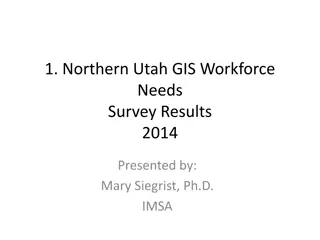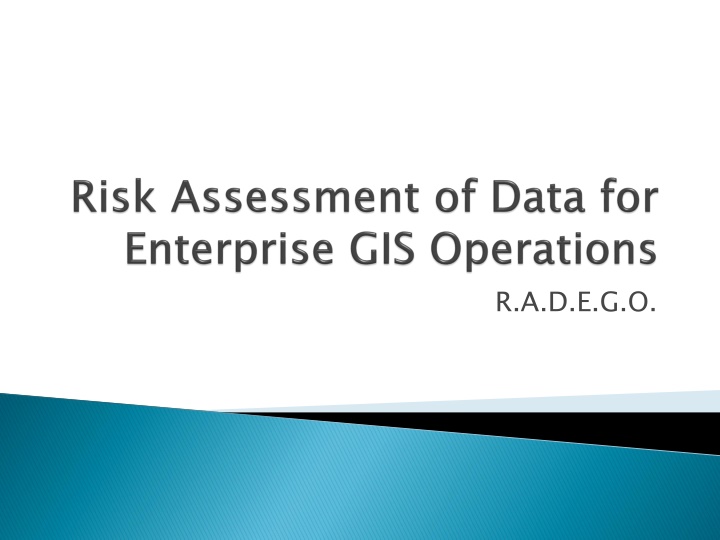
Data Quality Decision Support for Enterprise GIS Operations
Improve business decisions and data quality maintenance in Enterprise GIS operations with RADEGO methodology. Evaluate currency accuracy, risks, effort, and precision to streamline operations. Assess risks and impacts for effective decision-making using RADEGO. Understand the importance of metadata and maintenance history in maintaining GIS data layers efficiently.
Download Presentation

Please find below an Image/Link to download the presentation.
The content on the website is provided AS IS for your information and personal use only. It may not be sold, licensed, or shared on other websites without obtaining consent from the author. If you encounter any issues during the download, it is possible that the publisher has removed the file from their server.
You are allowed to download the files provided on this website for personal or commercial use, subject to the condition that they are used lawfully. All files are the property of their respective owners.
The content on the website is provided AS IS for your information and personal use only. It may not be sold, licensed, or shared on other websites without obtaining consent from the author.
E N D
Presentation Transcript
Business decisions based on data quality require: Data Origin/Background Data Maintenance History Metadata: data quality, however: Metadata: can typically answer most questions about Requires user investment/specific knowledge to interpret Decision support requires data mastery and time. RADEGO Ownership RADEGO: Saves time by simplifying Risk of Impact of Use and RADEGO: Risk Assessment of Data for Enterprise GIS Operations
RADEGO Methodologies Evaluate Currency Accuracy Risk Effort Precision Method Assumptions: Establish Impact of Risk and Frequency of Risk Impact Help departments prioritize layer maintenance scheduling Net effect: determination of staffing required to keep GIS data layers in an Enterprise GIS Data Warehouse up-to-date Scoring of GIS Data simplifies the Risk Ownership Risk and Impact Impact of Use Use and Ownership of a GIS dataset to a 9 point data test. RADEGO: Risk Assessment of Data for Enterprise GIS Operations
Variables to Assess: 1. Scoring represents a dataset s level of risk/impact to an organization. Positional Accuracy (Y) 2. Typological Accuracy (Y) 3. Metadata Compliancy (Y) Scores have both a real world value and a semi-quantitative value (0-20). 4. Level of One-Time Maintenance (X) 5. Level of Routine Maintenance (X) 6. Frequency or Rate of Change (X) 7. Automation Capability (X,Y) 8. Combined Impact: (X,Y) Frequency of Use Impact (X) Decision Risk Impact (Y) RADEGO RADEGO: R Risk A Assessment of D Data for E Enterprise G GIS O Operations
United States National Mapping Accuracy (NMAS) Standard of precision based on level of published scale Smaller Scales (< 1:20,000) <= 1/50 inch error Larger Scales (> 1:20,000) <=1/30 inch error Planimetric accuracy values for NMAS at common scales: RADEGO: Risk Assessment of Data for Enterprise GIS Operations
Larger datasets (>1,000 records): NMAS 10% sample size for a dataset Smaller Datasets (< 1,000 records): Statistically significant sample size determined RADEGO: R RADEGO: Risk A Assessment of D Data for E Enterprise G GIS O Operations
Sample Size Random Grid of Point Test Locations Locations are assessed for accuracy of positional error Pass Pass or Fail Fail Percentage Percentage RADEGO Score RADEGO Score These values will affect the Y Y or impact axis of the risk matrix. RADEGO: R RADEGO: Risk A Assessment of D Data for E Enterprise G GIS O Operations
Accuracy of categorical attributes (i.e. geology, vegetation, flood plain values, etc) Sample tested against a known dataset of field values These values will affect the Y Y or impact axis of the risk matrix. RADEGO: Risk Assessment of Data for Enterprise GIS Operations
Operationally critical to prevent or avoid risk Metadata assessment is binary Is a dataset s metadata complete? Is it compliant with SanGIS regional metadata standard? These values will affect the Y Y or impact axis of the risk matrix. RADEGO: Risk Assessment of Data for Enterprise GIS Operations
Effort required raise a dataset up-to-date or current Expressed in hours of labor Can involve any level of effort or difficulty to accomplish These values will affect the X X or impact axis of the risk matrix. RADEGO: Risk Assessment of Data for Enterprise GIS Operations
Effort required keep keep a dataset up-to-date or current Expressed in hours of labor per year Can involve any level of effort or difficulty to accomplish These values will affect the X X or impact axis of the risk matrix. RADEGO: Risk Assessment of Data for Enterprise GIS Operations
Rate of change in a dataset Expressed in time periods: Hours Hours - - Months Months - - Years Years - - Never Never Datasets that represent a unique event in Space or Time: RADEGO Score = 0 RADEGO Score = 0 (No maintenance / Always Up-to-Date) These values will affect the X X or impact axis of the risk matrix. RADEGO: Risk Assessment of Data for Enterprise GIS Operations
Automation matters greatly when determining risk Ideal systems are automated in their maintenance Automation = Reduction in Human Error & Ensures Maintenance These values will affect the X and Y (impact & frequency axis of the risk matrix) X and Y RADEGO: Risk Assessment of Data for Enterprise GIS Operations
Frequency of Use (rate) & Impact Level of Decision (risk) Shows level of reliance on a dataset by an Organization High impact reflects how critical a dataset is to Dept. Impact Level of Decision affect the (Y) impact axis Rate of Use scores affect the (X) frequency axis Rate of Use (X) Frequency of Use (rate) & Impact Level of Decision (risk) (Y) impact axis (X) frequency axis Impact Level of Decision (Y) Impact Level of Decision (Y) Rate of Use (X) RADEGO: Risk Assessment of Data for Enterprise GIS Operations
ESRI Geodatabase Domains created with coded integer values RADEGO Scores for each Assessment Table Schema created with field for each RADEGO Assessment Value and Domains applied to each field Accordingly coded integer values reflecting RADEGO: R RADEGO: Risk A Assessment of D Data for E Enterprise G GIS O Operations
Table of 70 LUEG-GIS SanGIS Responsible layers Merged with RADEGO table schema Assessed by LUEG-GIS Staff based on their specific knowledge Initial Assessment: Does Not include Positional or Typological Accuracy Prioritizes, based on RADEGO Score, which layers should be assessed for: Accuracy (Positional / Typological) Initial Assessment Positional or Typological Accuracy Prioritizes, based on RADEGO Score, which layers should be assessed for: Accuracy (Positional / Typological) RADEGO: R RADEGO: Risk A Assessment of D Data for E Enterprise G GIS O Operations
RADEGO: R RADEGO: Risk A Assessment of D Data for E Enterprise G GIS O Operations
RADEGO: R RADEGO: Risk A Assessment of D Data for E Enterprise G GIS O Operations
RADEGO Methodologies Evaluate Currency Accuracy Risk Effort Precision Method Assumptions: Establish Impact of Risk and Frequency of Risk Impact Help departments prioritize layer maintenance scheduling Net effect: determination of staffing required to keep GIS data layers in an Enterprise GIS Data Warehouse up-to-date Scoring of GIS Data simplifies the Risk dataset to a 9 point data test. Risk and Impact Impact of Use Use and Ownership Ownership of a GIS RADEGO: Risk A Assessment of D Data for E Enterprise G GIS O Operations RADEGO: R


